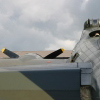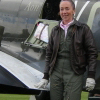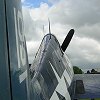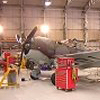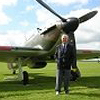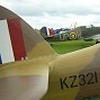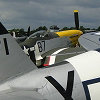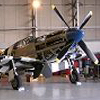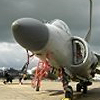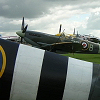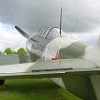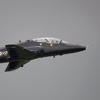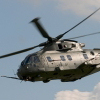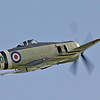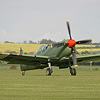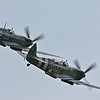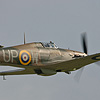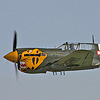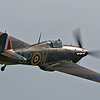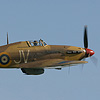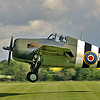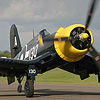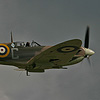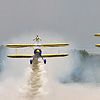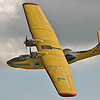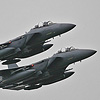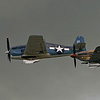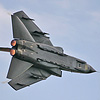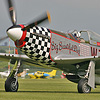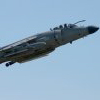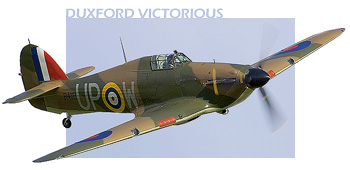
Duxford VE Day Air Show 2005 Review
Saturday 7th May - Sunday 8th May
Celebrating sixty years since the end of hostilities in Europe, the Imperial War Museum at Duxford couldn't have expected to be faced with a battle of their own in attempting to put on an air display in the face of strong gusting winds and torrential downpours. The first airshow of the year at the wartime Battle of Britain base in Cambridgeshire traditionally carries great expectation amongst warbird fans as being the first airshow for many of a new season and can often boast a number of debutantes. The event held over the weekend of the 7th and 8th of May was no exception.
braved the elements to bring you this report. Additional photography by , and .
Like myself, many of the attendees at the Duxford VE Day Anniversary Air Show will have read in the aviation press over the dark winter months of the news of the latest restorations and imports to the UK Warbird scene and been hopeful of being amongst the first to see them in the air. Sadly two of these stayed in the hanger, still receiving attention from the magicians hands. Talking of hangers, it was also a chance to see the progress on the work on the AirSpace project. Currently very open plan!
'Razorback' P-51C Mustang Princess Elizabeth owned by Stephen Grey's The Fighter Collection last flew in 1997 and has been through a major strip down and restoration. Although she has been ground run, no flights have yet taken place - but are imminent. TFC's other 'fresher', the recently imported Curtiss Hawk 75, is still undergoing rebuild after it's trip across from Chino, California. Both of these exciting additions should be in the air for July's Legends.
Perhaps the most historically important warbird restoration in many years did thankfully make it into the flying program. Peter Vacher, one time a restorer of purely land based Rolls Royce machinery, paid a visit to India in 1982 in search of 'new' car projects and spied a Hurricane in a Hindu University which had been in use as an instructional airframe. It wasn't until Peter, and his wife Polly, had gained their 'wings' in Australia and then returned to the UK to continue the business that they considered trying to see if the Hurricane could be purchased and brought back to the UK. A trip to India in 1996 confirmed that the airframe was still there and a decision was made to buy it. Five years of negotiations eventually succeeded in bringing her home!
Hawker Hurricane Mark 1 R4118 was delivered to it's first active RAF squadron on 17 August 1940 and flew 49 sorties during the Battle of Britain, shooting down a number of enemy aircraft. One of her pilots from this period, Wing Commander Bob Foster, was reunited with 'his' aircraft at the show. During his sorties in R4118 Bob scored two damaged Ju 88s, and shared in the 'kill' of another. This Hurricane can definitely claim to have played it's part in the Victory in Europe.
Duxford itself also had a large part to play in the conflict. RAF fighters took to the skies to protect their homeland from attack and invasion, winning many victories but also suffering withering losses. Eventually the 'Battle of Britain' was won and the tide turned towards an offensive posture. In 1943 the 78th Fighter Group of the US Eighth Air Force moved in with firstly P-47 Thunderbolts, and then P-51 Mustangs, and tasked with escorting the bomber forces deep into enemy territory. Once the Allies had gained air superiority the fighters also performed ground attacks on 'targets of opportunity'. So it was until Tuesday 8th of May 1945. 'VE Day'.
Sixty years later it was time to celebrate the victory, and remember those who gave their lives. Fittingly entry was free to the over sixties, to some of which we undoubtedly owe so much. A short flying display was planned for both the Saturday and Sunday, consisting of a mix of warbirds supported by current offerings from all three colours of the UK's armed forces, plus, on the Sunday only, a flypast salute from the USAF in the form of two F-15Es based at Lakenheath in Suffolk, but operating from RAF Brize Norton for the weekend.
The F-15s were in fact scheduled to open the Sunday display at exactly 13:37, but this looked doubtful when one of the weekend's many dark and menacing weather fronts moved through just before. Somehow it cleared enough in time for the two Strike Eagles to make their pass in the dry, and saved many a camera from a soaking!
A 100 Squadron Hawk performed it's usual precise routine, and a soon to be extinct Navy Sea Harrier FA2 was displayed on the Saturday before going 'tech' and missing the Sunday show, but top honours for fast jet display must go to the Tornado GR4 - even though it had to make to with it's 'flat' show. A paraffin burner from an earlier age in the shape of the Golden Apple's T-33 Silver Star, flown by Mark Linney, illustrated the effectiveness of it's dayglo panels as it manouvred around the very dark sky, but this show was really about the warbirds, and they didn't fail to impress.
The final 'first-footer' for the weekend was a new take on a familiar shape. Carolyn Grace's two seat Spitfire has been around for many years. Although configured with the added second cockpit, it flies in the scheme that it wore during action over the D-Day invasion beaches as a single seat fighter. Debutant Spitfire T9 '161' , on the other hand, has come out of the Propshop restoration hanger in authentic trainer colours, as it would have looked when in use by the Irish Air Corps, in it's service post-war. These two trainer Spits were joined in the display by Charlie Brown in the HAC's Spitfire Vb, and OFMC's indomitable Mark IX MH434. A beautiful sight and sound as the classic fighters wheeled around the sometimes angry looking skies. The Royal Navy Historic Flight Sea Fury made a very welcome appearance after its long delayed return to the circuit for the 2004 season. Well worth the wait and a lovely sight.
The Fighter Collection had a busy weekend, launching groups of warbirds on the Sunday to take part in a salute over Southampton and returning to grace the Cambridgeshire skies. Their Navy trio of Corsair, Hellcat and Wildcat were joined by their P-40E Kittyhawk, and P-51 Mustangs from the OFMC and, on Sunday, Rob Davies' immaculate Big Beautiful Doll. These in various combinations of formations and tail chases, along with the aforementioned Hurricanes and Spitfires were a perfect tribute to the battles over Europe in the dark days of war. Special mention must be made of the P-47 Thunderbolt 'No Guts No Glory' which flies in the checkerboard colours of the USAAF when flying operations from Duxford.
In recognition of the massive part played by Russian forces in the eventual victory, a single display by a Yak-11/C-11 trainer variant made a pleasing change from the norm. Rob Davies flew his own version on the Saturday (preferring to bring his Mustang on the Sunday), while Angie Soper brought her lovely green/grey example on the Sunday. We must not forget the important roles played in the conflict by less celebrated types. Fighter pilots needed to learn their skills somewhere, and for many that would have been on the T-6 Harvard/Texan - two immaculate examples of which made a very welcome addition to the display - or the Boeing Stearman - another two of which appeared in the show, but this time in the much more commonly seen hands of the Utterly Butterly Barnstormers with their girls on the wing routine. These lighter types must be congratulated for battling the high gusting winds prevalent on both days, but especially the Saturday. The same must of course be said for the other examples of what are often grouped under the term communications aircraft which carried out a myriad of vital roles. The Dragon Rapide G-AGJG and the C-45 Expeditor illustrated the larger of such types, and were complemented by a routine by a Fiesler Storch and an L-4 Cub. The latter two of which were especially well handled in the conditions.
A type of aircraft that played a vital role in the drive through Europe towards victory but perhaps understandably missing from the flying programme was the assault glider. The carriage of troops to the front lines and beyond was therefore represented by it's more modern equivalent, that of the battle field helicopter. The AAC Blue Eagles appeared with a temporary two-ship display of one Gazelle AH1 and one Lynx AH7, which was basically the solo section of their familiar display with the Lynx performing it's looping and back flip party tricks. The other rotary display was one which could well become the season's favourite in much the same way as the Chinook of 2004. A Merlin HC3 of 28 Squadron RAF threw its great bulk around the skies to much acclaim. Unfortunately missing from the show were examples of the larger 'heavies'. Plain Sailing's PBY Catalina gave possibly it's final outing in it's colourful ‘Rasta' colour scheme before a planned repaint, while the BBMF Lancaster could only make a single pass in formation with the flight's Spitfire PR19 and Hurricane IIc on the Sunday because of cross wind restrictions at it's home base in Lincolnshire. Perhaps the saddest sight of all though was to see the Boeing B-17 Sally B sitting forlornly watching the display. Recent EU regulations has unwittingly grouped Sally B in with a heavily increased insurance requirement aimed at commercial jet liners. Elly Sallingboe and her team are unable to meet this massive extra cost and are fighting to have the B-17 exempted in some way. Hopefully we will soon see her back where she belongs - as a flying memorial to those that gave their lives sixty years and more ago.
The VE-Day Anniversary show was a fitting tribute to victory of 1945, and a victory over the British weather of 2005.
Congratulations and thank yous to all involved.

